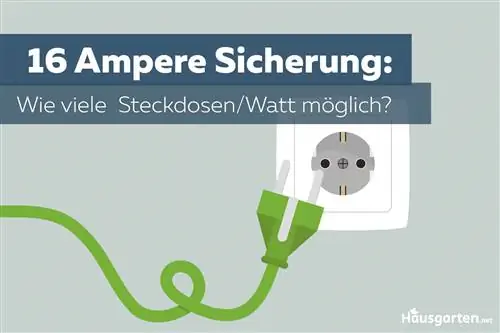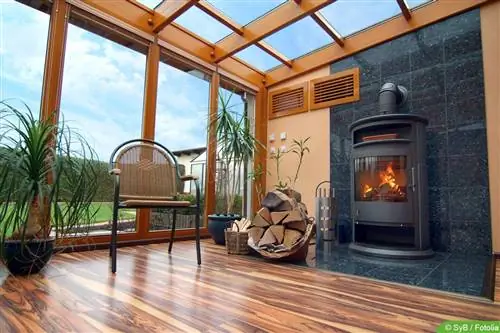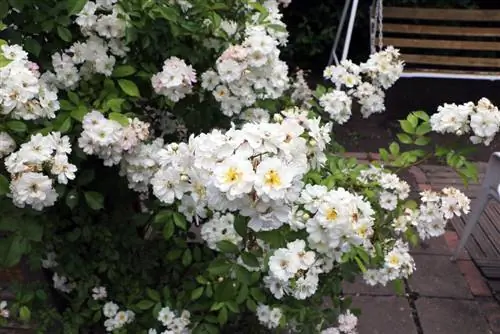- Author admin [email protected].
- Public 2023-12-17 03:39.
- Last modified 2025-06-01 06:48.
If a fuse keeps blowing, the circuit and the load must be checked. From a purely mathematical point of view, it's easy, but there are also some challenges.
Units
Three variables play a role in the calculations. These are:
- Ampere
- Volt
- Watt
Ampere (A) is the unit of electrical current. It indicates the number of electrical charges that flow through a conductor in a certain period of time. The larger the number, the greater the current.
Volt (V) is the electrical voltage. This indicates the amount of energy present in charge carriers. The wattage (W) is the unit for power. It describes the energy turnover in a fixed period of time.
Tip:
All three factors play a role in the connection between fuses, sockets and consumers. This also applies to the calculations.
Resilience
The common fuses are designed for 230 volts. The maximum load is calculated by multiplying the two values.
16 A x 230 V=3680 W
A circuit with a single fuse may therefore only be loaded up to this point. Otherwise it will be interrupted for safety reasons and a power consumer must be removed before it can be started up again.
In purely mathematical terms, 16 sockets or 16 devices with a consumption of 230 W each could be connected per circuit. In reality, planning and use is somewhat more difficult. Because electrical devices have very different wattages. It is therefore worthwhile to be able to roughly estimate the consumption of the respective devices.
Consumption
It makes sense to know the consumption or wattage of the devices when purchasing them. This makes it easier to estimate the total load on a fuse circuit. The energy efficiency class and the type of device play an important role. The following example can illustrate this better.
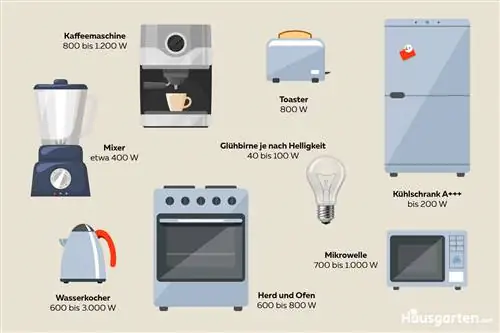
A modern refrigerator with energy efficiency class A+++ consumes less than 200 watts during operation as a freestanding device without a freezer compartment. This means that 18 refrigerators could be operated continuously per 16 amp fuse without causing a failure. A modern hairdryer, on the other hand, requires 1,000 to 2,000 watts. In practice, this means that only two to a maximum of three devices per backup circuit can be operated at the same time without risking failure.
Tip:
The faster a device has to provide high performance, the higher the consumption is usually. Therefore, a vacuum cleaner puts more strain on electricity than, for example, a permanently connected landline telephone.
Sockets per fuse
In theory, determining the number of sockets or the number of devices is very easy. The number of devices and their respective consumption are added together.
However, the following points should be taken into account:
- Ceiling lamps are usually on the same circuit
- Defects can lead to overloading
- not all electricity consumers are used at the same time
- different devices have different wattages
It therefore makes sense not to fully exploit the maximum load. This may be easier in some rooms than others.
Example numbers
In a large living room there are often two ceiling lamps. Added:
- Router 8 W
- Telephone 5-7 W
- TV 100 W
- Receiver 5-15 W
- Floor lamps 20 W
- DVD/Blue-Ray player 0.5W (stand-by) - 25W (operating)
- Music systems 20 W (basic device) + up to 50 W amplifier + up to 40 W for speakers
- Game consoles approx. 200 W
These alone can run at the same time. However, if a vacuum cleaner is added, cell phones are charged or a notebook is connected, the fuse circuit can be overloaded and tripped.
For this reason, it is advisable to build a buffer into the calculation. The actual consumption should therefore be below the maximum load limit. Because no one will be able to accurately add up all the factors when using a socket or running multiple devices at the same time.
Information for orientation
A few points can be used as a guide when planning and assigning the number of sockets:
- per single socket 200 to 300 W
- per double socket 300 to 500 W
- per slot in power strips 250 W
This planning makes it easier to estimate consumption quickly and thus prevent the burden from becoming too high. Of course, it also plays a role which and how many devices are currently drawing power. Never use more than ten slots with running devices per fuse circuit. For electrical appliances with higher consumption, the number is reduced accordingly.
Caution: Risk of triggering
If devices are defective, the respective fuses may be briefly overloaded. The only thing that helps here is to test the different potential triggers one after the other. In this way, the relevant electrical device can be found and permanently removed from the fuse circuit. Otherwise, other connected devices, the slots themselves or the cables could also be damaged.
Orientation on electricity consumption
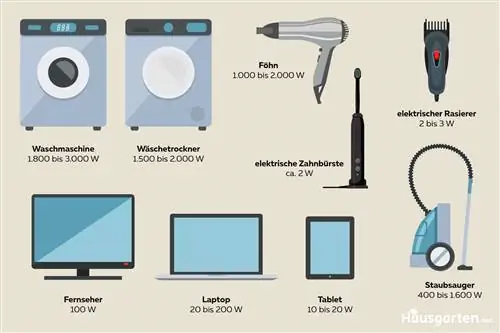
Since different electrical devices vary greatly in terms of consumption, we offer an overview of the devices frequently used in the household and their respective wattage:
- Bulb by brightness 40 to 100 W
- Washing machine 1,800 to 3,000 W
- Tumble dryer 1,500 to 2,000 W
- Vacuum cleaner 400 to 1,600 W
- electric toothbrush about 2 W
- electric shaver 2 to 3 W
- TV 100 W
- Laptop 20 to 200 W
- Tablet 10 to 20 W
- Mixer about 400 W
- Toaster 800 W
- Coffee machine 800 to 1,200 W
- Stove and oven 600 to 800 W
- Microwave 700 to 1,000 W
- Kettle 600 to 3,000 W
Devices with a high wattage also deliver strong performance. A kettle with around 2,000 W brings the water to the boil more quickly and therefore uses less electricity in the long run because it only runs for around two to three minutes. However, for this period it puts more strain on the fuse circuit than a device with 600 W.
Tip:
As a rule of thumb, the more power a device has to produce in a short time, the higher the consumption. Therefore, the consumption of a hair dryer is higher than that of a refrigerator. A hairdryer has to draw in large amounts of air, heat it up and release it again, while the refrigerator only has to reach the low temperature once and then maintain it. It is supported by the insulation and the already cooled food.

